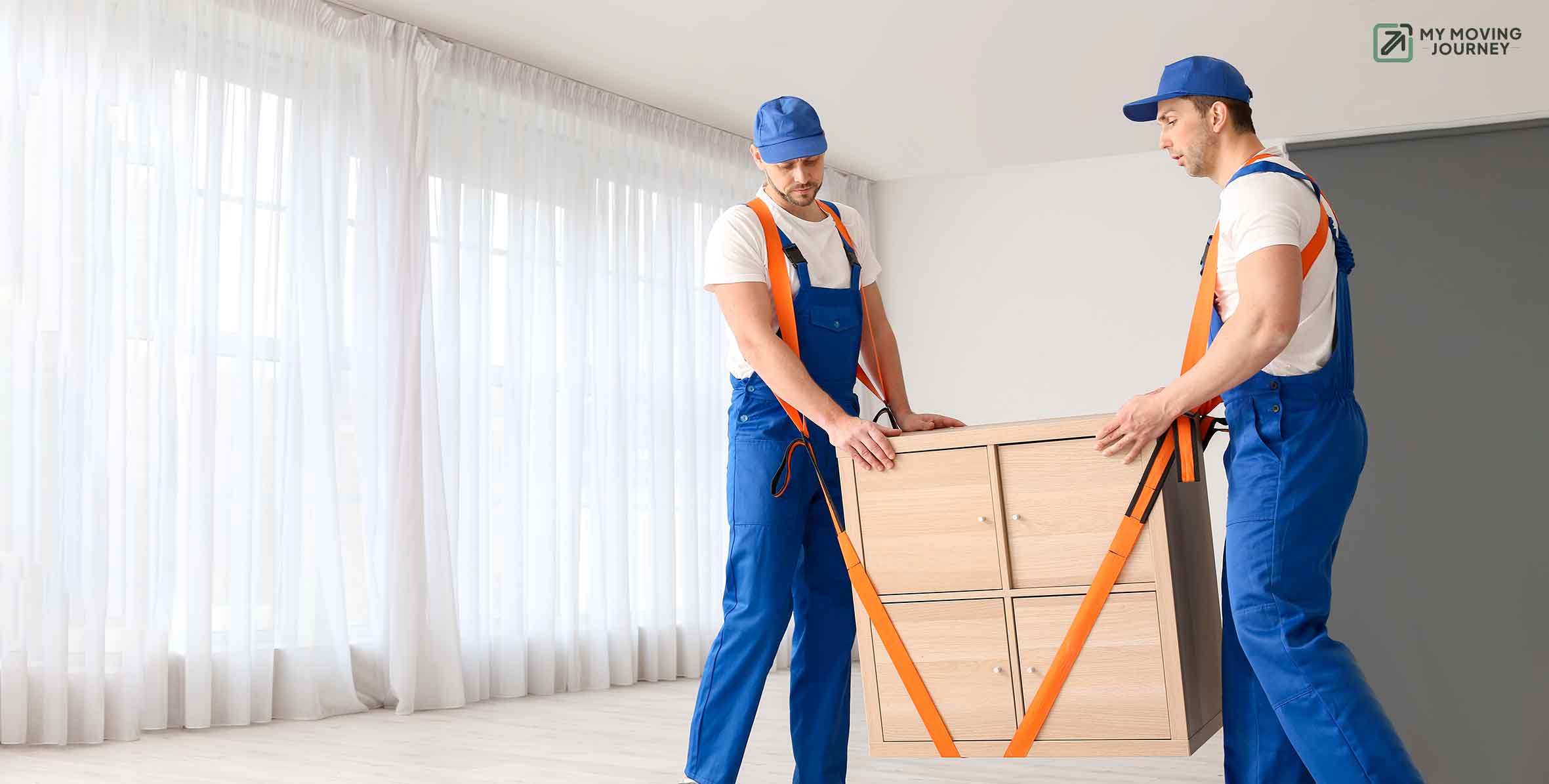Work smarter, not harder.
You've probably heard this before, and nowhere does it apply more perfectly than when you are moving heavy items. Whether it's a bulky sofa, an oversized fridge, or that treadmill you swore you'd use every day, moving these things can be exhausting—and even dangerous if done incorrectly.
In fact, the American Chiropractic Association reports that nearly 80% of Americans will experience back pain at some point in their lives, often caused by improper lifting techniques.
So, how do you avoid becoming part of this statistic? By using moving straps to move your heavy items? These tools can reduce the strain on your back and make moving heavy items feel significantly easier.
According to a study from the National Institute for Occupational Safety and Health (NIOSH), using moving straps can lower spinal compression forces by up to 50%, and a study from the Journal of Occupational and Environmental Hygiene found they can reduce peak exertion forces by 60% during lifting tasks.
With numbers like these, it’s clear that moving straps are not just an option; they’re a smart solution for anyone who wants to protect their body while performing a big move.
Let’s discuss exactly how to use moving straps effectively and why they are a better choice than traditional methods like hand trucks for many moving tasks.
What Are Moving Straps and their Types?
Moving straps are specially designed tools that help distribute the weight of heavy items, making them easier to lift and transport. They work by shifting the load from your arms to your more powerful leg and back muscles, allowing you to carry bulky objects with reduced strain and less risk of injury.
Types of Moving Straps
There are a few different types out there, and each one is designed to handle specific tasks.
1. Forearm Straps (Forearm Forklift)
These are probably the most common type of moving straps and are great for those large, awkward items like couches or dressers. Forearm straps wrap around your forearms, using the strength of your arms and shoulders to lift. Here’s why they work:
- Weight Distribution: Forearm straps take some of the load off your back and distribute it to your forearms.
- More Grip: The design gives you extra grip, which makes the object feel lighter than it actually is.

According to a study published in the Journal of Applied Ergonomics, using forearm straps reduces exertion by up to 40% compared to traditional lifting techniques.
These straps are ideal for items that are lower to the ground or those with a lower centre of gravity. Plus, they are super adjustable, making them easy to use for people of different heights.
2. Shoulder Straps (Shoulder Dolly)
Shoulder straps are another popular type of moving strap, especially for large or tall items like refrigerators or tall bookshelves. They work by using the shoulders and upper body for lifting instead of the arms. Here’s what you should know:
- Even Weight Distribution: Shoulder straps evenly distribute the weight across your shoulders and back. It reduces the strain on your arms and gives you a hands-free experience.
- Better for Tall Items: Since the straps go over your shoulders, they work better for taller, bulkier items, where forearm straps might not be as effective.
- Risk Reduction: Studies from the National Institute for Occupational Safety and Health (NIOSH) have shown that shoulder straps can lower the risk of lower back injuries by up to 80% compared to traditional lifting methods.
- Hands-Free Operation: The beauty of shoulder straps is that they leave your hands free to help balance or manoeuvre the item, which is especially useful when steering tight spaces or stairs.
3. Appliance Straps
These heavy-duty straps are designed specifically for moving large appliances like refrigerators, washing machines, and stoves. If you have ever tried moving a fridge, you know how tricky it can be. Appliance straps make this task much more manageable:
- Secure Gripping: Appliance straps come with secure grips that are designed to hold large, heavy objects safely, ensuring you have full control while moving.
- Floor Protection: One key benefit of using these straps is that they protect both the appliance and the floor from damage during the move.
- Injury Prevention: A survey conducted by the American Chiropractic Association found that movers using appliance straps experienced 70% fewer back injuries than those using traditional lifting methods.
These straps are essential when moving anything heavy and expensive that you don’t want to risk damaging during a move.
4. Hand Truck Straps
While not technically a "moving strap" in the same sense as forearm or shoulder straps, hand truck straps deserve a mention. These are the straps you use to secure items on a hand truck or dolly, preventing them from sliding off during transport.
- Great for Stacked Boxes: Hand truck straps are perfect for securing stacks of boxes, furniture, or other items that might otherwise shift during transport.
- Best for Long, Flat Moves: If you are moving items over long, flat distances (like from the moving truck to the house), hand trucks with straps can be a better option than lifting with moving straps.
5. Lifting Harness
For the most intense moving jobs, you might want to consider a lifting harness. This is essentially a full-body strap system that allows you to lift extremely heavy items—like pianos or industrial machinery—without putting too much strain on any single part of your body.
- Professional-Level Support: Lifting harnesses are often used by professional movers for oversized or extremely heavy items.
- Superior Weight Distribution: These harnesses distribute weight across your entire body, making even the heaviest objects easier to handle.

According to ergonomic studies, full-body harnesses can reduce the risk of injury by over 85% when used correctly.
Related articles:
How To Use Plastic Wrap For Moving
Most Common Things People Forget to Pack
How Do Moving Straps Work?
Moving straps are designed to distribute weight evenly across your body, engaging your stronger muscle groups. Here's a step-by-step on how to use them:
- Position the Straps: Slide the moving straps under your lifting item. Make sure they are evenly placed for balanced weight distribution.
- Adjust for Fit: Adjust the straps around your shoulders or forearms, depending on the type you are using, and make sure they are snug but not too tight.
- Lifting Technique: Keep your back straight and bend your knees as you lift the item. This allows you to use your leg muscles for the lift, which are much stronger than your back muscles.
- Move Slowly: When lifting, communicate with your partner (if using two-person straps) and move in a synchronized manner to prevent any imbalance or sudden weight shifts.
- Maneuvering Obstacles: Plan your route and clear any potential obstacles. When moving through tight spaces or stairways, communicate frequently with your partner and take breaks if necessary.
How to Secure Items with Moving Straps
One key advantage of moving straps is their ability to secure items during transport. To do this effectively:
- Ensure the straps are wrapped tightly around the object.
- If using adjustable straps, tighten the ratchet or buckle to secure the item in place.
- Keep the item close to your body while carrying it to maintain control and balance.
- If moving on stairs, make sure to have a spotter at the lower end for safety
Moving Straps vs. Hand Truck: Which Is Better?
A common question during moves is whether to use moving straps or a hand truck. Both have their pros and cons, depending on the situation.
| Feature | Moving Straps | Hand Truck |
|---|---|---|
| Weight Distribution | Spreads weight across the body | Puts weight on wheels |
| Control in Tight | Better manoeuvrability in tight areas | Requires more space to operate |
| Stairs | Easier for moving up/down stairs | Difficult to use on stairs |
| Best for | Bulky, heavy, or irregular items | Stacked boxes or flat items |
In general, moving straps are superior for handling bulky or irregular items, such as furniture or appliances. However, if you are moving stacked boxes or need to transport items over long, flat distances, a hand truck might be a better option.
How Much Do Moving Straps Cost?
When you are gearing up for a move, you are probably wondering, “How much do moving straps cost, and are they worth the investment?” The great news is that moving straps come at a variety of price points, depending on the type, brand, and features you need.
Let’s break it down so you know exactly what to expect.
The General Price Range
Typically, moving straps can range anywhere from $15 to $60 for a basic set. For heavier-duty straps or those designed for professional movers, you can expect to pay up to $100 or more. Here’s a quick breakdown of what you can get at different price points:
| Type of Strap | Price Range | Features |
|---|---|---|
| Basic Forearm Straps | $15 - $30 | Good for moving smaller furniture, adjustable, and easy to use. |
| Shoulder Dolly Straps | $30 - $50 | Distributes weight across shoulders, hands-free. |
| Appliance Straps | $40 - $80 | Heavy-duty, secure grip for appliances like refrigerators. |
| Professional Moving Straps | $60 - $100+ | Full-body harness, designed for large or awkward items. |
The more complex the strap system (like shoulder harnesses or heavy-duty appliance straps), the higher the price tends to go. But even at the higher end, investing in these tools can save you from potential injuries and accidents.
Additional Costs to Consider
While moving straps are a one-time investment, there are other related costs that can pop up during your move. Depending on the complexity of your move, you might need to consider these expenses:
| Item | Estimated Cost |
|---|---|
| Hand Truck (Dolly) | $60 - $150 |
| Furniture Pads | $15 - $40 each |
| Rope or Tie-Down Straps | $10 - $30 |
| Moving Boxes | $1 - $5 per box |
| Professional Moving Help | $80 - $100/hour |
Cost of Moving Straps by Brand
Different brands have different price points, and they often reflect the quality and durability of the straps. Here are some popular brands and what they typically charge for their moving straps:
| Brand | Product Name | Price Range |
|---|---|---|
| Forearm Forklift | Forearm Forklift Lifting Straps | $20 - $30 |
| Shoulder Dolly | Shoulder Dolly Moving Straps | $30 - $50 |
| Kangaroo Straps | Heavy Duty Moving Straps | $40 - $70 |
| Maasdam Pow'R Pull | Appliance Moving Straps | $50 - $80 |
| Heavy-Duty Harness | Lifting Harness for Pro Movers | $80 - $100+ |
What Affects the Price of Moving Straps?
Several factors can influence the price of moving straps:
- Type of Strap: Forearm straps are generally cheaper than shoulder or appliance straps because they’re simpler and use less material.
- Material Quality: Straps made from high-quality, durable materials (like nylon or heavy-duty webbing) cost more but last longer.
- Adjustability & Comfort: Straps with additional padding, adjustable buckles, and ratcheting systems are more comfortable to use but also add to the cost.
- Weight Capacity: The more weight the straps can handle, the higher the price. For instance, straps that can move 800 lbs or more (such as those designed for pianos or safes) are typically more expensive.
- Brand: Well-known brands like Shoulder Dolly or Forearm Forklift often cost more because of their reputation for quality and durability.
Safety Tips When Using Moving Straps
Safety is paramount when lifting heavy items, so follow these best practices:
- Wear proper footwear: Closed-toe, anti-slip shoes are essential.
- Don’t twist your body: Instead, pivot with your feet to avoid putting unnecessary strain on your back.
- Inspect your straps: Check for signs of wear and tear before use.
Know your limits: If the object is too heavy or you feel uncomfortable, don’t hesitate to ask for professional help






